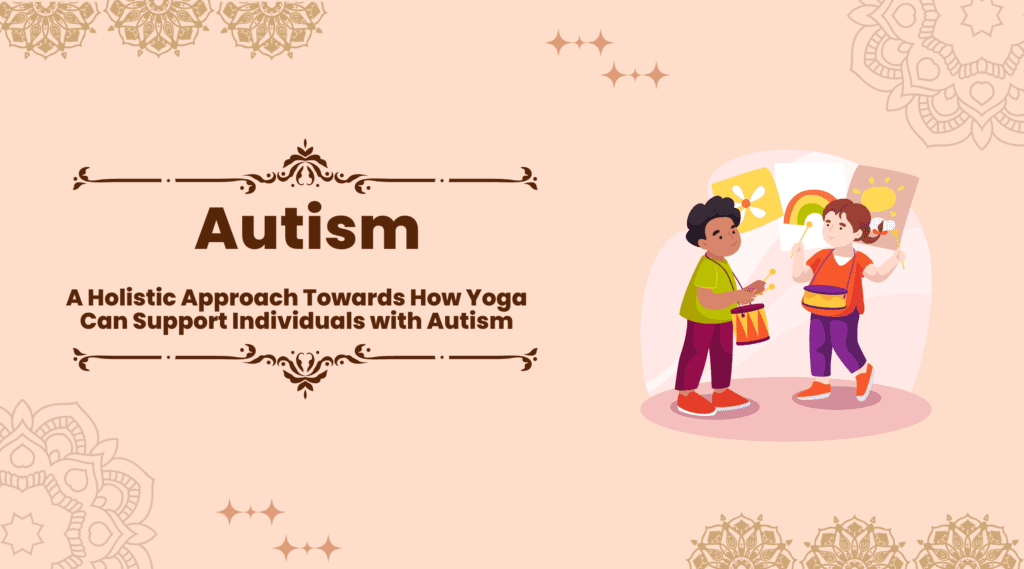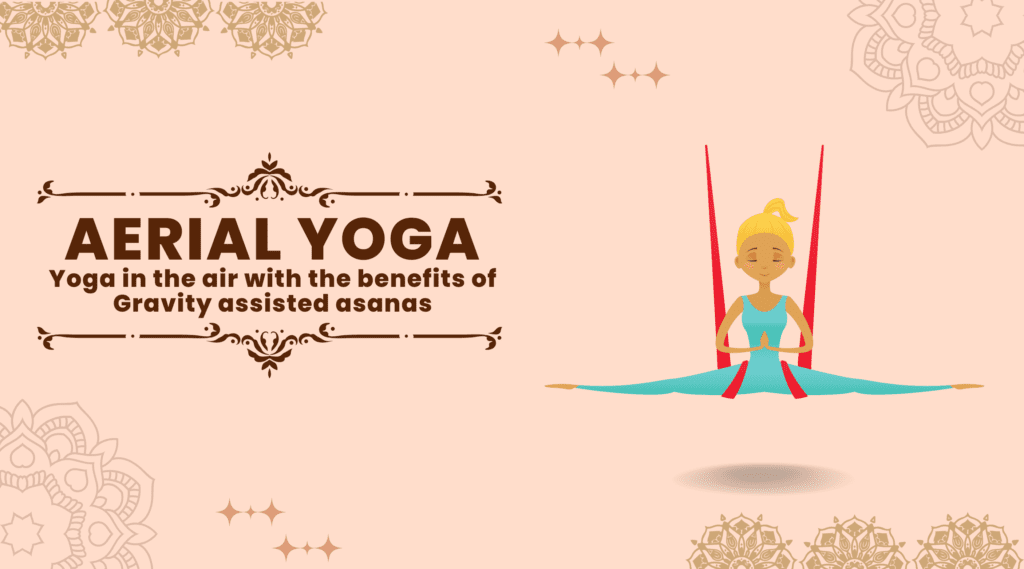Autism: A Holistic Approach Towards How Yoga Can Support Individuals with Autism

Introduction
Autism, also known as Autism Spectrum Disorder (ASD), is a neurodevelopmental disorder that affects how a person perceives and interacts with the world. It is characterised by difficulties in social interaction, communication, and the presence of repetitive patterns of behaviour or interests.
Autism is a spectrum disorder, which means that it manifests differently in each individual. Some individuals may require significant support in their daily lives, while others may be highly independent and successful in certain areas.
Individuals with autism may have challenges in social interactions and relationships. They may struggle with understanding and responding to social cues, such as facial expressions, body language, or verbal cues. They may find it difficult to initiate or sustain conversations, express emotions appropriately, or engage in imaginative play with others.
Autistic individuals often exhibit repetitive behaviours and have narrow, intense interests. They may engage in repetitive movements, such as hand-flapping, rocking, or spinning. They may also develop highly focused interests in specific topics or objects, often displaying extensive knowledge and expertise in those areas.
Sensory sensitivities are common in autism. Individuals may be over or under-sensitive to certain sensory stimuli, such as light, sound, touch, taste, or smell. This can lead to heightened sensory experiences or difficulties in processing sensory information, which may result in sensory overload or meltdowns.
Yoga can be a great help in managing autism. We will explore in this blog how yoga can be helpful for people with autism.
Suggested: Best Yoga Retreats And Yoga Teacher Training In Rishikesh
History of Autism
The history of autism can be traced back to the early 20th century when researchers noticed certain behaviours and developmental patterns in children that differed from the norm. Here is a brief timeline of some of the key developments in the history of autism:
1908: Eugen Bleuler, a Swiss psychiatrist, coined the term “autism” to describe a group of symptoms related to schizophrenia, including social withdrawal, language difficulties, and repetitive behaviours.
1943: Leo Kanner, an Austrian-American psychiatrist, published a landmark paper describing a group of 11 children with similar symptoms, which he called “early infantile autism.” He identified key features such as social withdrawal, communication difficulties, and repetitive behaviours, and suggested that the condition had a biological basis.
1960s-70s: Research into autism began to expand, with increased attention to the unique needs and abilities of individuals on the autism spectrum. In 1970, the first national conference on autism was held in the United States, which led to the formation of advocacy organisations and increased public awareness.
1980s: The diagnostic criteria for autism were revised in the third edition of the Diagnostic and Statistical Manual of Mental Disorders (DSM-III), which expanded the definition of autism to include a broader range of symptoms and age of onset.
1990s: As research continued, the concept of autism as a spectrum disorder began to gain acceptance, acknowledging the wide range of abilities and challenges experienced by individuals on the autism spectrum.
2000s: The prevalence of autism was found to be increasing, leading to a surge in research, advocacy, and public awareness. In 2013, the DSM-5 was published, revising the diagnostic criteria once again and combining several previously separate conditions, including Asperger’s syndrome, under the umbrella term “autism spectrum disorder.”
Today, autism is recognized as a complex and diverse condition that affects individuals in unique ways. The United Nations General Assembly officially declared April 2nd as Autism Awareness Day in 2007.
We also know it as World Autism Awareness Day. The goal of this day is, bringing global attention to autism as well as fostering understanding and support for individuals on the autism spectrum.
Since then, the day has been marked by various activities, events, and initiatives worldwide to educate communities, challenge stereotypes, and promote inclusion for individuals with autism.
Types of Autism
Though Autism Spectrum Disorder (ASD) has not been officially classified into different types of autism however, unofficially there are following kinds of autism:
Autistic Disorder (Classic Autism): This refers to individuals who exhibit significant impairments in social interaction, communication, and display restricted and repetitive behaviours. They may have delayed language development or be nonverbal. Classic autism is often associated with intellectual disability.
Asperger’s Syndrome: In the past, Asperger’s syndrome was considered a separate diagnosis but is now included within the umbrella term of ASD. Individuals with Asperger’s syndrome typically have average to above-average intelligence and may have good language skills but face challenges in social interaction, nonverbal communication, and may have intense interests or special talents in specific areas.
Pervasive Developmental Disorder-Not Otherwise Specified (PDD-NOS): PDD-NOS was a diagnostic category used to describe individuals who displayed some symptoms of autism but did not fully meet the criteria for autistic disorder or Asperger’s syndrome. It was used to capture a more heterogeneous group of individuals on the autism spectrum.
High-Functioning Autism (HFA): This term is sometimes used to describe individuals with autism who have average or above-average intelligence and demonstrate relatively good language skills. They may still experience social challenges and exhibit restricted and repetitive behaviours.
Level of Support: Instead of categorising autism into distinct types, the level of support needed by individuals is often assessed based on the severity of their symptoms and support requirements. The DSM-5 introduced three levels of support: Level 1 (requiring support), Level 2 (requiring substantial support), and Level 3 (requiring very substantial support).
It’s important to note that these terms are descriptive and may not capture the full diversity of experiences and characteristics within the autism spectrum.
Every individual with autism is unique, and their strengths, challenges, and support needs can vary significantly.
A comprehensive understanding of an individual’s profile should consider their specific abilities, challenges, and personal circumstances.
Symptoms of Autism
Autism Spectrum Disorder (ASD) is characterised by a wide range of symptoms that can vary in severity and presentation from person to person. The following are some common symptoms and behaviours associated with autism:
Social Interaction Challenges: Individuals with autism may have difficulties with social interaction, including:
Difficulty maintaining eye contact or understanding non-verbal cues.
Limited interest in or awareness of others’ emotions.
Difficulty initiating or responding to social interactions.
Challenges with developing and maintaining friendships.
Communication Difficulties: Communication impairments are common among individuals with autism and can manifest in various ways:
Delayed speech development or absence of speech.
Difficulty understanding or using gestures, facial expressions, and body language.
Literal interpretation of language, difficulty understanding humour, sarcasm, or abstract concepts.
Echolalia (repeating words or phrases) or unusual speech patterns.
Restricted and Repetitive Behaviours (RRBs): Individuals with autism often engage in repetitive patterns of behaviour or display narrow, intense interests, such as:
Repetitive movements, like hand-flapping, rocking, or spinning.
Strict adherence to routines or rituals and resistance to change.
Preoccupation or intense focus on specific objects, topics, or activities.
Sensory sensitivities or aversions, such as hypersensitivity to sounds, textures, smells, or tastes.
Sensory Sensitivities: Many individuals with autism experience heightened or reduced sensitivities to sensory stimuli, which can impact their daily lives:
Hypersensitivity: Overwhelmed by certain sounds, bright lights, certain textures, or crowded environments.
Hyposensitivity: Seeking sensory input, such as a need for deep pressure, repetitive movements, or intense sensory experiences.
Other Associated Features:
Intellectual and learning disabilities are common but not universal in individuals with autism.
Some individuals with autism may exhibit exceptional skills or talents in specific areas, such as mathematics, music, or visual arts.
Co-occurring conditions: Many individuals with autism may have additional conditions like attention-deficit/hyperactivity disorder (ADHD), anxiety, or epilepsy.
Causes of Autism
The exact causes of Autism Spectrum Disorder (ASD) are still not fully understood. However, research suggests that a combination of genetic, environmental, and neurological factors contribute to the development of autism. Here are some factors that have been studied and associated with autism:
Genetic Factors: There is strong evidence that genetics plays a role in autism. Many studies have shown that certain gene mutations or variations are more common in individuals with autism. It is believed that multiple genes, rather than a single gene, interact with each other and with environmental factors to increase the risk of developing autism.
Environmental Factors: Certain environmental factors may contribute to the risk of developing autism, although their specific impact is still being studied. These factors include prenatal exposures, such as maternal infections during pregnancy, exposure to certain medications or toxins, and complications during pregnancy or childbirth. However, it’s important to note that the majority of individuals with autism do not have a specific environmental cause identified.
Brain Development and Connectivity: Research suggests that disruptions in early brain development and connectivity may contribute to the development of autism. Differences in the structure and functioning of the brain, including abnormal patterns of neural connections, have been observed in individuals with autism. However, the exact mechanisms by which these differences occur and their relationship to autism symptoms are still under investigation.
Combination of Genetic and Environmental Factors: It is likely that the development of autism involves a complex interplay between genetic vulnerabilities and environmental factors. Some genetic predispositions may increase the susceptibility to environmental influences, and certain environmental factors may have a stronger impact on individuals with specific genetic profiles.
Autism is a highly heterogeneous condition, and the causes and contributing factors can vary from person to person. Ongoing research continues to deepen our understanding of the complex interplay between genetic and environmental influences in the development of autism.
How Can Yoga Help With Autism?
Yoga can be a beneficial practice for individuals with Autism Spectrum Disorder (ASD) by providing a range of physical, mental, and emotional benefits. Here are some ways in which yoga can help individuals with autism:
Sensory Integration: Yoga involves various movements, poses, and breathing exercises that can help individuals with autism regulate their sensory experiences. It provides opportunities for individuals to engage in controlled and structured movements, promoting body awareness, balance, coordination, and sensory integration.
Stress Reduction: Yoga incorporates relaxation techniques, deep breathing exercises, and mindfulness practices that can help reduce stress and anxiety levels. It can provide individuals with autism with tools to self-regulate and manage their emotions in challenging situations.
Body Awareness and Motor Skills: Practising yoga can enhance body awareness and proprioception, which refers to the sense of the body’s position and movement in space. Yoga poses and sequences can improve motor planning, coordination, and gross and fine motor skills.
Improved Focus and Attention: Yoga practices emphasise concentration and mindful awareness of the present moment. Regular yoga sessions can enhance attention span, focus, and the ability to stay present, which can be beneficial for individuals with autism who may struggle with attention and hyperactivity.
Social Interaction: Group yoga classes provide opportunities for social interaction and practising social skills in a supportive and inclusive environment. Yoga can facilitate nonverbal communication, cooperation, and turn-taking, promoting social connections and a sense of belonging.
Emotional Regulation: Yoga encourages self-reflection, emotional awareness, and self-regulation. It can help individuals with autism develop coping strategies, manage sensory overload, and express emotions in a healthy and constructive manner.
Body Confidence and Self-Esteem: Engaging in yoga can promote a positive body image, self-acceptance, and self-esteem. As individuals experience their bodies in different poses and develop physical skills, it can foster a sense of accomplishment and confidence.
It’s important to note that when introducing yoga to individuals with autism, it should be tailored to their specific needs, abilities, and preferences. Modifications and adaptations may be necessary to accommodate sensory sensitivities, motor challenges, and individual preferences. Working with a trained yoga instructor or therapist experienced in working with individuals with autism can ensure that the practice is safe, enjoyable, and beneficial.
Yoga Poses For Autism
Here are some yoga poses that are generally well-suited for individuals with autism:
Mountain Pose (Tadasana): This pose helps promote grounding, body awareness, and posture alignment. Stand tall with feet hip-width apart, arms relaxed by the sides, and focus on steady breathing.
Tree Pose (Vrikshasana): This balancing pose can improve focus, concentration, and body awareness. Stand on one leg, place the sole of the opposite foot on the inner thigh or calf, and find a focal point to steady the gaze. Arms can be extended overhead or in a prayer position at the heart centre.
Child’s Pose (Balasana): This calming and grounding pose helps release tension and promotes relaxation. Kneel on the floor, bring the forehead down to rest on the mat, and extend the arms forward or rest them alongside the body.
Cat-Cow Pose (Marjaryasana-Bitilasana): This gentle flow between two poses helps to release tension in the spine, improve coordination, and promote body awareness. Begin on all fours, arch the back up like a cat (cat pose), and then lift the chest and tailbone, dropping the belly toward the floor (cow pose). Repeat the movement smoothly and slowly.
Bridge Pose (Setu Bandhasana): This pose can help strengthen the core, stretch the spine, and promote relaxation. Lie on the back with knees bent and feet flat on the floor. Lift the hips off the floor, pressing into the feet and shoulders, and interlace the hands underneath the body. Hold for a few breaths and gently release down.
Savasana (Corpse Pose): This final relaxation pose encourages deep relaxation, calmness, and integration. Lie down on the back, arms resting alongside the body, and allow the body to relax completely. Focus on slow, deep breathing and letting go of tension in the body and mind.
But remember, it’s important to seek guidance from a trained yoga instructor or therapist experienced in working with individuals with autism to ensure a safe and beneficial practice tailored to their specific needs.
Conclusion
Autism Spectrum Disorder (ASD) is a complex neurodevelopmental condition affecting individuals in unique ways. While the exact causes of autism are not fully clear, research suggests that a combination of genetic, environmental as well as neurological factors contribute to its development.
Yoga can offer various benefits for individuals with autism. It provides opportunities for sensory integration, stress reduction, improved body awareness, motor skills development as well as enhanced focus and attention. It can also provide social interaction, emotional regulation as well as increased body confidence and self-esteem.
But it is necessary to approach yoga for individuals with autism with sensitivity, considering their unique challenges and strengths.
Working with trained instructors or therapists experienced in working with individuals with autism can ensure a safe and well tailored practice.
Also, integrating yoga into a comprehensive treatment plan, along with other therapies and interventions, can support the overall well-being and development of individuals with autism.
You Can Also Read:



